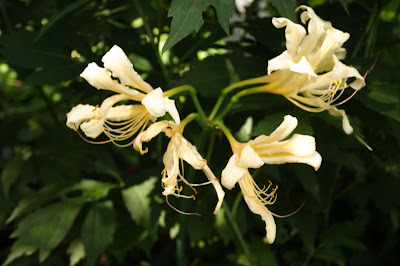This is a climbing form of a once famous Polyantha rose. The Polyantha roses are one rose group about which I know very little: they have never had much interest for me. That lack of interest has an easy explanation: in the neighborhood where I grew up in Silver Spring, Maryland there were several gardens with plants of the Polyantha rose ‘Margot Koster’. The flowers of this rose have a daring color, a sort of shrimp pink. Attractive as they are when fresh, they fade unpleasantly. An old bloom is to my eyes ugly, blotched with unharmonious colors and frankly dirty looking. On top of that, the plants were small and runty looking. This caused me to write off the Polyantha roses.
Now fast forward about fifty years. I was in another garden and overheard some rose enthusiasts talking about the rose ‘Marie Pavie’: in fact, several of the plants were right there for me to see for myself why this rose pleased them so much. I was surprised to hear that it belonged to the Polyantha class. Maybe it was time for me to take another look at the Polyanthas. In fact, a plant of ‘Marie Pavie’ was soon added to the rose plantings.
In my rose reading I had frequently encountered the name ‘Clotilde Soupert’, and the name was almost always accompanied by words of praise. That made enough of a favorable impression to keep the name in my memory. The time came when I needed an extra rose to fill out a rose order, and I hit on the climbing form of ‘Clotilde Soupert’. When the plant bloomed for the first time this year, I had one of those “where have you been all my life” experiences: it’s that good.
This rose does not do brash, spectacular, flashy, exciting, blast of color, torrents of bloom or related extremes. It’s just the opposite: a very quiet rose, sweetly fragrant, one which when it opens has a very pleasing radial symmetry and globular form. I’m so glad to have netted this one in time.
























